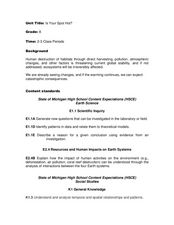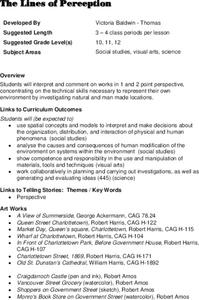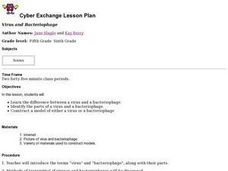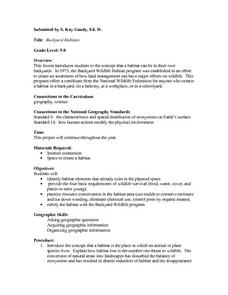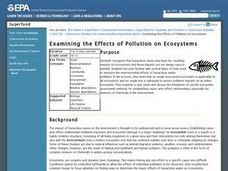Curated OER
Location, Location, Location: Civilization's Ultimate Advantage
Students discover how geographical advantages, locational and regional, ultimately led to western Eurasian societies' disproportionate accounting of world power and innovation. They utilize a workbook which can be downloaded within this...
Curated OER
Salt: White Gold
Middle schoolers examine the importance of salt for trade routes and the economy of a community.
Curated OER
Shake, Rattle and Roll
Students explore how to locate the location of an earthquake and why earthquakes happen more frequently in some areas more than others.
Curated OER
Sandscapes to Landscapes
Pupils explore landscapes and create their own in a creative project.
Curated OER
Through the Looking Glass: Recognizing Developing and Industrialized Countries
Young scholars examine the regions of the world, and identify the basic characteristics of industrialized and developing countries. They conduct Internet research on the economic and population characteristics of industrialized and...
Curated OER
Technology and Oil
Students demonstrate how much our society depends on petroleum products. They show how advances in technology have allowed us to find, obtain, and transport oil more efficiently.
Curated OER
Behind the Mission to Mercury
High schoolers read an E-Sheet about the Mission to Mercury. They follow a variety of worksheets and on-line activities that follow the E-Sheet. They discuss several different scenarios regarding space exploration. They analyze one of...
Curated OER
Write It, Read It, Solve It
Writers create an original mystery and have a chance to put it into movie format. The classic elements of a mystery must be present: the crime, the suspects, the motive, the solution and clues. Use iPhoto and Quicktime Movie to integrate...
Curated OER
U.S. and Canada: How are We the Same? How are We Different?
Get high school geographers to compare and contrast Canada and the United States. They begin by drawing a freehand map of North America, then complete readings to gain insight into Canada. The text is not provided; however, another text...
Curated OER
Sharks At Risk Viewing Guide
Students complete a worksheet while viewing a film about sharks. They examine the reasons for overfishing of the oceans. They identify predator-prey relationships as well.
Curated OER
Technology and Oil
Students examine how society depends on petroleum products. They determine how technological advances have improved the ways these products are obtained, found, and transportation.
Curated OER
Regional Landforms and Native People
Third graders study the Native American tribes of Maidu and Miwok by studying Internet artifacts, culture, language, music, storytelling, architecture, food, clothing, crafts and geology.
Curated OER
Is Your Spot Hot?
Eighth graders explore global warming. In this Earth Science lesson plan, 8th graders will look for Harbingers and fingerprints for different areas. The students will identify an area at risk and they will then create a...
Curated OER
TE Lesson: Land on the Run
Students study the causes of different types and speeds of landslides. They determine that landslides are the result of gravity, friction, and the materials involved. They examine the step engineers are taking to prevent and avoid...
Curated OER
Kidney Pools: Are They Fair?
Learners examine the kidney donation process and make ethical decisions as various stakeholders in specific case studies. They decide which candidate should receive a kidney donation.
Curated OER
The African and the Pequot in Colonial America
Learners determine that the lands the English settled on were owned and inhabited by 70,000 Indians. They consider that the London Company sold land charters to the English, which gave them illegal title to lndian land and that the...
Curated OER
The Lines of Perception
Students interpret and comment on works in 1 and 2 point perspective. They locate the focal point of works done in 1 point perspective and create a drawing of a street or landscape in their local area using 1 point perspective.
Curated OER
Virus and Bacteriophage
Students examine the differences between a virus and a bacteriophage. They explore various websites, identify the parts of a virus and a bacteriophage, and construct a model of a virus or bacteriophage.
Curated OER
Backyard Habitats
Students identify habitat elements. They create a habitat in a backyard, on a balcony, at a workplace, or in a schoolyard and provide the four basic requirements of wildlife survival (food, water, cover, and places to raise young). They...
Curated OER
Wild About Wildfires
Students conduct a debate. In this wildfire and controlled burning instructional activity, students watch the video "Legacy of Fire" and discuss the topic of wildland fires and controlled burns. Half of the class researches the...
Curated OER
The Sun Affects Earth
Third graders read, write, and listen to information about the sun and its effects on the Earth.as it relates to its axis, orbit, rotate, and revolution. In this solar system lesson, 3rd graders examine how the sun...
Curated OER
Visualizing Succession
Ecosystem change is easier to understand when you use hands-on activities.
Curated OER
Carbon Adventures Game
Sixth graders examine the processes and transformations that occur in carbon pools. They play a game to identify paths taken by carbon through the environment.
Curated OER
Examining the Effects of Pollution on Ecosystems
Students examine the different types of tests used to measure the environmental effects of hazardous waste. They work together to determine the impact of pollution on different ecosystems. They read a case study and answer questions to...












